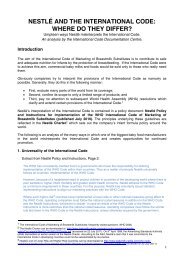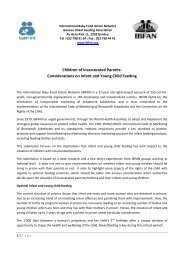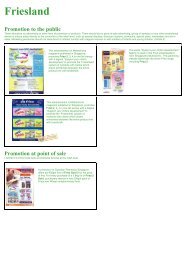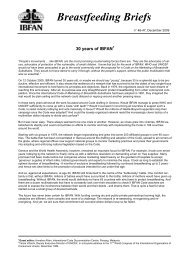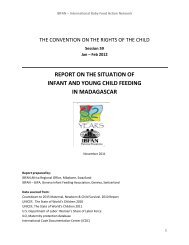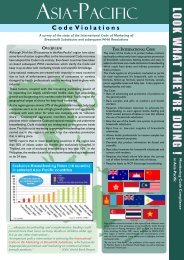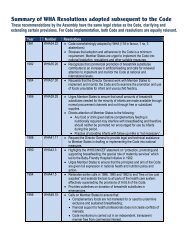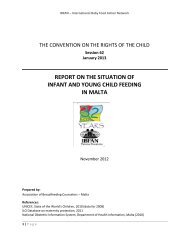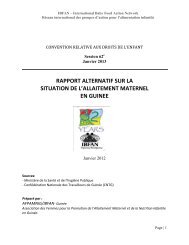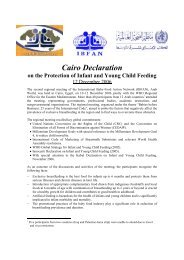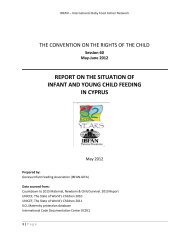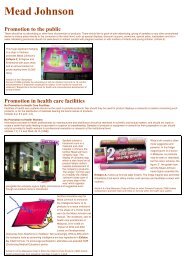You also want an ePaper? Increase the reach of your titles
YUMPU automatically turns print PDFs into web optimized ePapers that Google loves.
MORINAGA<br />
52<br />
Promotion in health facilities<br />
� WHA Resolution 47.5 (1994) urges an end to free or<br />
subsidised donations of products to all parts of the health<br />
care system.<br />
� Article 5.2 and 5.4 of the Code prohibit companies from<br />
giving samples and gifts to mothers.<br />
� Morinaga donates unsolicited supplies of Morinaga<br />
BMT to health facilities in Indonesia and health workers<br />
give them to mothers as free samples.<br />
� In Indonesian health facilities, company representatives<br />
obtain mothers’ contact information through<br />
midwives and call mothers directly to promote<br />
Morinaga BMT and other company products.<br />
� Morinaga promotional materials are distributed in<br />
health facilities in China and Indonesia.<br />
� Morinaga gives baby cots with the company name<br />
printed on it to health facilities in Indonesia.<br />
Labelling<br />
� Article 9 of the Code requires labels to<br />
NOT discourage breastfeeding and to<br />
inform about the correct use of the<br />
product and the risk of misuse.<br />
� Morinaga’s Hagukumi infant formula<br />
labels in Japan have a cartoon<br />
drawing of a baby and idealise the<br />
product by comparing it to<br />
breastmilk.�<br />
� The Morinaga BF label in China states that “the product<br />
is like healthy breastmilk”.<br />
� In Indonesia the Chil Mil label shows a baby with a<br />
bottle and claims the product contains DHA and vitamins<br />
for brain development and growth.<br />
Misleading text and pictures<br />
which violate the Code<br />
� Article 4.2 requires all information material to advocate<br />
for breastfeeding and not contain pictures or text which<br />
idealises the use of breastmilk substitutes.<br />
� For health professionals, Article 7.2 of the Code only allows<br />
product information which is factual and scientific.<br />
� A leaflet for Morinaga Baby Water in Japan encourages<br />
bottle feeding, recommending that it be used<br />
Breaking the Rules, Stretching the Rules 2004<br />
to prepare infant formula. It<br />
says Baby Water “does not<br />
break down the mineral balance<br />
of formula milk and is<br />
therefore ideal for preparing<br />
formula”.�<br />
A cartoon baby appeals:<br />
“Mom, make our milk with<br />
‘Baby Water’, please!”<br />
� An advertisement in a maternity and child health<br />
monthly newsletter for health workers in Japan, promotes<br />
Hagukumi formula by stating “A lot of things<br />
we learned from breastmilk”.<br />
� In Japan, a maternity health handbook contains an<br />
advertisement for Morinaga’s Hagukumi together<br />
with a packshot and the formula’s website at:<br />
www.hagukumi.ne.jp<br />
� A leaflet in Japan compares<br />
Morinaga’s Chirumiru<br />
Ayumi follow-up formula<br />
(for use from nine months)<br />
with breastmilk, saying that<br />
like breastmilk, it contains<br />
lactoferrin to help build resistance<br />
to disease.�<br />
� In Japan a Morinaga leaflet creates fears and confusion<br />
in mothers’ minds, warning: “If you feed cow<br />
milk, which contains less iron, instead of breastmilk<br />
or powdered milk, the risk of iron anaemia will increase<br />
… It might stunt your baby’s physical and<br />
mental development.” It also says: “If you are<br />
breastfeeding, it is recommended to continue<br />
breastfeeding and start feeding follow-up milk<br />
around nine months because iron intake is likely to<br />
be deficient around this period.”<br />
International Baby Food Action Network -- <strong>IBFAN</strong>



